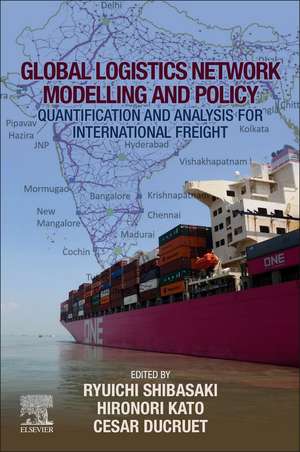Global Logistics Network Modelling and Policy: Quantification and Analysis for International Freight
Editat de Ryuichi Shibasaki, Hironori Kato, Cesar Ducrueten Limba Engleză Paperback – 8 sep 2020
This book provides quantitative tools for modeling, analysis, and simulation of worldwide, inter-modal cargo movement – helping forecast the impacts of logistics and related policies in each region of the world. It covers useful applications for every region of the world, allowing policymakers to tailor results for their own specific uses.
- Delivers sophisticated quantitative tools for modeling simulations, providing powerful analysis of global intermodal cargo movements
- Features examples of tools applied to logistical policy situations in every region of the world
- Serves as a bridge between theory and practice in the field of freight transportation research
- Provides detailed, data-supported case studies and real-world examples for transportation modelers, planners and policymakers
Preț: 550.81 lei
Preț vechi: 753.69 lei
-27% Nou
Puncte Express: 826
Preț estimativ în valută:
105.41€ • 109.64$ • 87.02£
105.41€ • 109.64$ • 87.02£
Carte tipărită la comandă
Livrare economică 08-22 aprilie
Preluare comenzi: 021 569.72.76
Specificații
ISBN-13: 9780128140604
ISBN-10: 0128140607
Pagini: 370
Dimensiuni: 152 x 229 mm
Greutate: 0.49 kg
Editura: ELSEVIER SCIENCE
ISBN-10: 0128140607
Pagini: 370
Dimensiuni: 152 x 229 mm
Greutate: 0.49 kg
Editura: ELSEVIER SCIENCE
Public țintă
High-level undergraduate and graduate students enrolled in social sciences transportation programs. Transportation professionals involved with planning, feasibility studies, consultation, funding, and policy for transportation infrastructure. Government researchers and policy makers responsible for international logistics employed at state and federal departments of transportationCuprins
Part One General introduction
1 Introduction to global container shipping market
2 A global analysis of hinterlands from a European perspective
3 Cross-border logistics practices, policies, and its impact
4 Basics of container demand forecast
Part Two Model & data
5 Basic concept
6 Global maritime container shipping model
7 Intermodal transport super-network model
8 Data [1] maritime shipping and land transport network
9 Data [2] container shipping demand for the present and future
Part Three Application to the developing world
10 Central America: Small countries with active border-crossing transport on land
11 Greater Mekong Subregion: Is the Mekong River shipping competitive with other modes?
12 South Asia: Impact simulations of logistics projects in India, Bangladesh, and Sri Lanka
13 Central Asia: Typical landlocked region across Eurasia continent
14 Pacific Islands: Small and dispersed ‘sea-locked’ islands
15 Southern Africa: Overcoming corridor and border challenges for landlocked countries
16 Belt and road initiative: How does China’s BRI encourage the use of international rail transport across the Eurasian continent?
1 Introduction to global container shipping market
2 A global analysis of hinterlands from a European perspective
3 Cross-border logistics practices, policies, and its impact
4 Basics of container demand forecast
Part Two Model & data
5 Basic concept
6 Global maritime container shipping model
7 Intermodal transport super-network model
8 Data [1] maritime shipping and land transport network
9 Data [2] container shipping demand for the present and future
Part Three Application to the developing world
10 Central America: Small countries with active border-crossing transport on land
11 Greater Mekong Subregion: Is the Mekong River shipping competitive with other modes?
12 South Asia: Impact simulations of logistics projects in India, Bangladesh, and Sri Lanka
13 Central Asia: Typical landlocked region across Eurasia continent
14 Pacific Islands: Small and dispersed ‘sea-locked’ islands
15 Southern Africa: Overcoming corridor and border challenges for landlocked countries
16 Belt and road initiative: How does China’s BRI encourage the use of international rail transport across the Eurasian continent?
